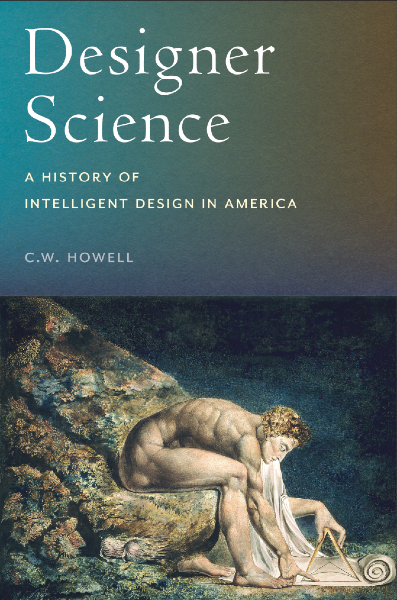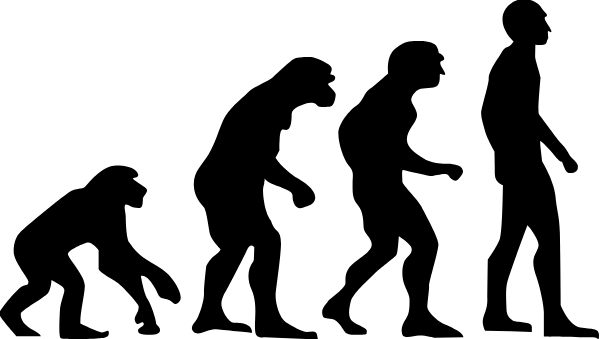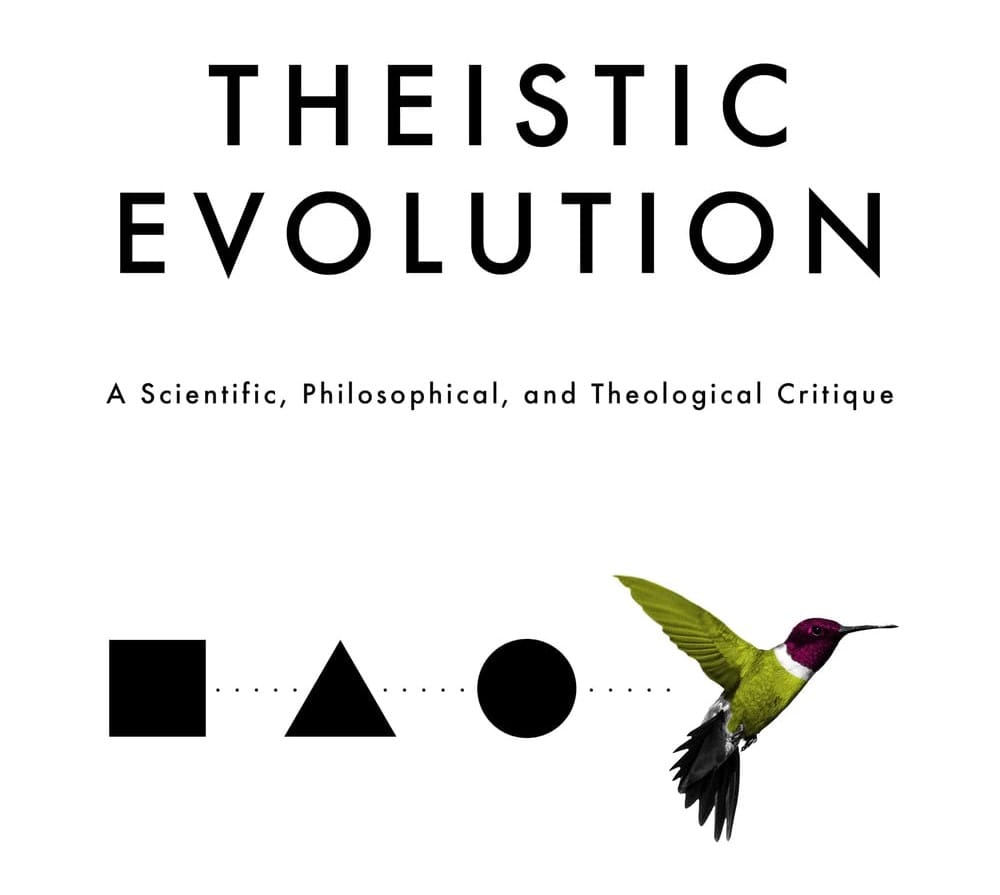My Book on Intelligent Design

I was asked by Eclectic Orthodoxy to write a review essay of David Bentley Hart’s new book All Things Are Full of Gods, which came out in late August. It’s a massive and challenging tome on philosophy of mind, but it was truly exceptional. You can find my review below, in case you missed it.

It took me a bit longer to write than anticipated because I had to revisit a lot of the history of evolutionary biology.
It was good timing, though, because I have news on that front.
My book on intelligent design, entitled Designer Science, has a cover and a tentative release date (September 2025). I love the way it looks:

This book has been a long time coming. I started work on it in 2017, when I shifted my dissertation research towards the history of intelligent design (ID). From 2017 to 2019 I was in the research phase (which included taking my preliminary exams as a PhD student), and from 2019 to the end of 2020 I wrote the dissertation. I defended it in March of 2021.
It was an interesting time to do a PhD, as COVID had necessitated a shutdown of most of the facilities at Duke, and so many students didn’t have access to the libraries for roughly six months. I was very fortunate in this regard, because books on ID are pretty accessible and I was able to order most of what I needed online. I did not need to access archives of old manuscripts or rare books like some of my colleagues in, for example, New Testament studies needed to.
In 2022, I pitched the book to NYU Press, and it was accepted. I spent much of 2023 expanding and revising the book, including adding sections on the philosophy of science and artificial intelligence. It will come out next year as both a hardcover book and an ebook.
Design and Creation

If you’re unfamiliar with intelligent design, it is an anti-Darwinist movement that started in the late 1980s and rose to prominence in the 1990s and early 2000s, before ultimately fading from public view after a disastrous court case in 2005 (Kitzmiller v. Dover). But it never went away after that, even if media interest moved on. Based largely out of the Discovery Institute in Seattle, ID supporters continue to draw support and funding, and they publish books promoting their views. They have also lately expanded into criticism of artificial intelligence.
One of the major questions with ID is whether it was the same thing as creationism.
And, like any good historian, I have to qualify my answer with a stirring and definitive “that depends.”
Creationism comes in a lot of guises and can mean a lot of things. If it’s deployed to mean blanket anti-Darwinism or, slightly more expansive, antievolution in general, then yes, ID is creationist.
But often, by creationist, we mean a specific approach to both the Bible and science that was born out of the Fundamentalists in the early 20th century, with more rigorously literal dedication to scripture and Christian doctrine. William Jennings Bryan, who defended the state of Tennessee’s right to bar evolution from being taught in the Scopes “Monkey” Trial of 1925, is emblematic of this kind of creationism. But, interestingly, creationism of that time largely accepted an old Earth, and was even sometimes open to evolution of animals or non-Darwinian evolution. A weird historical “fun fact” is that a few of the authors of “The Fundamentals,” the pamphlets from which the Fundamentalists got their name, were surprisingly tolerant of evolution.
B.B. Warfield, one of the most influential thinkers behind biblical inerrancy, was also open to evolution in certain instances, as was chronicled by the historians Mark Noll and David N. Livingstone in their article “A Biblical Inerrantist as Evolutionist.” Bryan, for his part, held to an old Earth. So did the Scofield Reference Bible, the ultimate guide for Fundamentalist readers of the Bible.
In the 1960s, things changed with the advent of flood geology and young-Earth creationism. It is this form of creationism that most people have in mind when they use the word. It encapsulates the usual stereotypes: the earth is only six-thousand years old (give or take), the Genesis Flood is the determinative geological event in human history (which is responsible for fossils, for instance), they are manifestly opposed to uniformitarianism in science (the dictum that the “present is the key to the past”), and they have a bedrock commitment to the fixity of species.
The great historian Ronald Numbers, who I was fortunate to work with on my dissertation, wrote the definitive book on creationism: The Creationists. He showed, conclusively, that young-Earth creationism and flood geology in fact had their roots in Seventh-day Adventism, and that the growth of young-Earth forms of antievolution in American evangelicalism was not some self-evident or inevitable evangelical reading of the Bible, but a relatively new phenomenon from the middle of the 20th century, one which had its origins in a religious movement (Adventism) of which evangelicals are often skeptical.
Flood geology eventually rebranded as scientific creationism, and this form of creationism (which was also young-Earth and focused on the flood) was defeated in local court cases like in 1981 (McLean v. Arkansas) and in the Supreme Court in 1987 (Edwards v. Aguillard).
It was after these legal defeats that intelligent design emerged as an alternative to creationism and a new opponent to Darwin. I agree with Ronald Numbers on this, I don’t think intelligent design is the same thing as creationism—but that always depends on what you mean by the word “creationist.” And even though it has its differences, it did grow out of creationism and often reuses many of its arguments (even if the overall worldview has changed).
What was ID, then?

In the 90s, many of its adherents took to calling it a “Big Tent,” and this is one of the most helpful ways to understand it. Because, even though its adherents were all skeptical of Darwin, they often had rather different angles on it. There were young-Earth creationists in its ranks, as well as old-Earth creationists, theistic evolutionists who held to non-Darwinian forms of evolution, and even an agnostic or two. Their attacks on Darwin were often identical to creationism, but the angles from which they approached it differed.
Most of them were religious, and most held to old-Earth views of creation. For this reason, it was relatively easy for its opponents to highlight its similarities to creationism. And this was critical, for legal precedent is of enormous strategic importance for ID’s legal survival.
IDers themselves focused on attacking evolution through perceived weak points, especially in molecular biology. The complexity of life, especially at the biochemical level, was one of their chief targets. Two of their most important arguments—specified complexity and irreducible complexity—were dedicated to highlighting portions of evolutionary theory that were apparently fraught with explanatory difficulty. These tactics functioned almost like Big12 football: all offense, no defense.
The reason this mattered is because IDers were influenced by developments in the history and philosophy of science. Thomas Kuhn, in particular, was critical—for he provided them a template for how science evolves and changes.
Kuhn’s conception of history was that scientific knowledge progresses through the development and then abandonment of paradigms. A classic example would be the replacement of geocentrism with heliocentrism, or of Newtonian physics with quantum physics. Ordinary scientific research—what he called “normal science”—was done under the auspices of the paradigm that reigned in its time. But, slowly, anomalies would accrue and become harder to explain (in geocentrism, for instance, the movement of the planets was the fatal obstacle), and scientists must resort to more and more ad hoc solutions. At some point, the paradigm gets so overloaded with anomalies that it breaks down, a revolution occurs, and a new paradigm takes its place.
IDers saw their ideas this way. They believed that if Darwinian theories of evolution were overloaded with enough anomalies, they could help hasten its breakdown, and then it would be replaced with a new paradigm, one that was amenable to theism. Their scientific program could then, theoretically, proceed.
A Political Movement

ID became a political movement almost from the get-go. It was wrapped up with conservative politics, but not (at least at first) in the populist, rabble-rousing manner that we’ve seen around the world lately. ID was more cerebral and urbane, and its conservative roots could be found in the thought of philosophers and historians like Russell Kirk and Richard Weaver, or public figures like William F. Buckley. This old form of antievolution was often Catholic and traditionalist, not evangelical and populist.
But that said, ID rapidly achieved some political successes, and was adopted by American culture warriors who sought to change the textbooks of public schools. The introduction of antievolutionary ideas into science curricula around the USA triggered a number of court cases, from Ohio to Georgia to Kansas. But the most important one took place in Dover, Pennsylvania.
In some ways, ID succeeded too fast politically. It had its attacks on Darwin and its political program, but it did not have a scientific paradigm to replace it with. When the Kitzmiller v. Dover case started drawing national attention, many of ID’s most important figures were wary. A number of them actually backed out of participation. Some cast doubt on the law firm that represented the creationists on the school board, the figures who triggered the court case by bringing Of Pandas and People (an ID textbook) into their school.
But ID was nevertheless dragged along, and the trial went poorly. The mendacity of the creationists on the school board earned everyone’s disfavor, as they repeatedly lied about what they did and why they did it. And ID’s best expert witnesses faltered under cross-examination by the lawyers from the ACLU and firm Pepper Hamilton.
The court case was a big blow for ID, and it couldn’t even be appealed because the Dover Board that implemented the pro-ID policy was voted out of office and the new board wanted nothing to do with it.
Blowback

The hits kept coming, too, for ID came under assault from two very different foes: the New Atheism and theistic evolution.
The New Atheists function almost like a photo-negative of ID, or an evil twin. Figures like Richard Dawkins, Christopher Hitchens, Sam Harris, and Daniel Dennett roared onto the scene with books that were not just critical of religion but actively hostile to it. Religious people weren’t just wrong, they were stupid—maybe even evil. But what’s interesting that the New Atheism shared a lot of similarities with ID, as both saw science as the best tool for investigating God’s existence. Both believed that God is a hypothesis.
(The conservative turn that the New Atheists have taken in recent years—with, for example, Richard Dawkins cozying up to Jordan Peterson—should not really be that surprising. Beneath their anti-religious pyrotechnics, the New Atheists were often right-leaning liberals with a vested interest in protecting what they believed to be the heritage and legacy of western civilization. The shared hostility toward Islam among many Christians and New Atheists seems to be kind of glue—and was also the impetus behind Ayaan Hirsi Ali’s conversation from the New Atheism to Christianity in 2023).
On the other hand, the theistic evolutionists did not see science at all in the same way as ID or the New Atheists. Whereas the New Atheists were opponents of ID, theistic evolution seemed to be its actual enemy—even if (maybe especially if) its adherents were practicing Christians.
It’s hard to argue that the theistic evolutionists were really the winners of the battle between ID and New Atheism. They’re simply too small for that. But after Francis Collins’s book The Language of God, and his subsequent founding of the BioLogos Foundation (which is dedicated to harmonizing Christianity with evolution), theistic evolution became a live option for many Christians, where before it was hardly even known. The consequence of this was that ID was not the sole option for those who would otherwise be its natural constituency.
Then to Now

After the court cases and the attacks from the New Atheists and the theistic evolutionists, ID seems to have lost a lot of its public attention, but it hasn’t gone away. Their writing and publishing has continued apace, and they still secure support and funding for it.
But their tone and demeanor has changed in important ways. In order to explain their lack of success, their inability to redefine and change how science is done, ID supporters often turned to more conspiratorial thinking. Their arguments were right, but the playing field isn’t fair. They’re being kneecapped by the establishment, by the experts.
We’ve become very familiar with this attitude of suspicion and cynicism. It seems, in the 21st century, to be the dominant form of political discourse.
Conservative groups have long resisted Darwinism, but now we see doubts extending from evolution to virtually every form of scientific knowledge: climate change, HIV causing AIDS, the efficacy of vaccines, even, at times, the theory of relativity. It’s not just a conservative trend either, liberal groups were the original anti-vaxxers, and it is in left-wing youth that pseudoscience like astrology is in vogue. The term “conspirituality” was coined a few years ago to explain growing beliefs in magic, ungrounded approaches to health and wellness, and the proliferation of New Age quackery like energy manipulation or baubles like crystals (mostly but not exclusively a left-wing phenomenon).
Everyone doubts everything. If you’re in a position of authority, if you’ve devoted your life to research, then you are automatically suspect, by simple virtue of the fact that you are an expert. It’s a noxious situation, because, to paraphrase Michael Polanyi, cynicism is just gullibility in reverse.
ID did not create these conditions. It’s part of a longer and deeper trend. But their frustration at their defeat in 2005, and their increasing sense of grievance and paranoia afterwards, has certainly intensified it. They were quite willing to embrace this kind of rhetoric and position themselves as heroic martyrs whose only sin was “just asking questions.” It’s something that we’re reckoning with daily, and I’m not exactly sanguine about the future of academic research or simply agreed-upon human knowledge as a result.
At the same time, ID has also engaged in some positive and, from my perspective, potentially unifying research. Their recent founding of the Walter Bradley Center for Natural & Artificial Intelligence is the kind of thing that might bear good fruit. As both education and business is being convulsed by AI (seemingly with entirely negative results), it’s critical for people across the ideological spectrum to push back against the dehumanization that AI is foisting upon us. This is exactly what ID proponents have been trying to do at the Bradley Center. One of their primary concerns is that humans should not be treated or understood as machines—a common theme on this site, and a view that I share with them.
I don’t know whether this will lead to increased cooperation with theistic evolutionists and atheists, but it would great if it did. When ID proponents have abandoned writing about Darwin and focused on AI, they have actually managed to get some of their books published by major academic presses like Harvard and Oxford. Perhaps there is a path there.
But, as the saying goes, it’s hard to make predictions—especially about the future.
Designer Science
Designer Science is slated for a release in September 2025. I will keep you apprised of its developments as we get closer to the release date. It’s been a great experience—and I look forward to its publication.






Member discussion